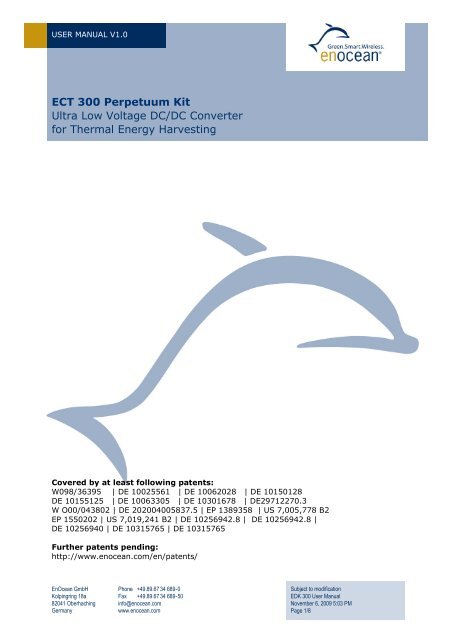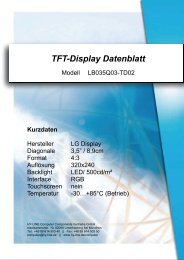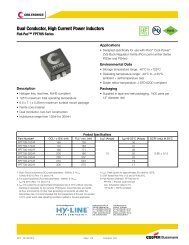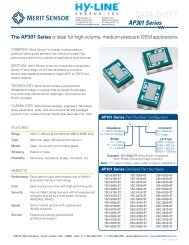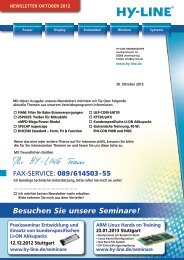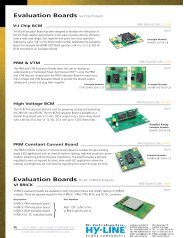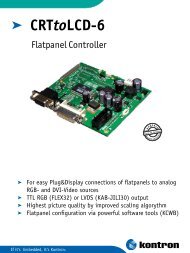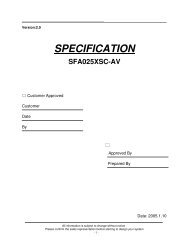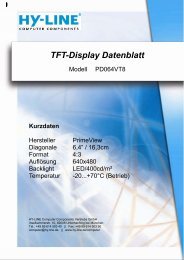ECT300 Kit User Manual
ECT300 Kit User Manual
ECT300 Kit User Manual
Create successful ePaper yourself
Turn your PDF publications into a flip-book with our unique Google optimized e-Paper software.
USER MANUAL V1.0<br />
ECT 300 Perpetuum <strong>Kit</strong><br />
Ultra Low Voltage DC/DC Converter<br />
for Thermal Energy Harvesting<br />
Covered by at least following patents:<br />
W098/36395 | DE 10025561 | DE 10062028 | DE 10150128<br />
DE 10155125 | DE 10063305 | DE 10301678 | DE29712270.3<br />
W O00/043802 | DE 202004005837.5 | EP 1389358 | US 7,005,778 B2<br />
EP 1550202 | US 7,019,241 B2 | DE 10256942.8 | DE 10256942.8 |<br />
DE 10256940 | DE 10315765 | DE 10315765<br />
Further patents pending:<br />
http://www.enocean.com/en/patents/<br />
EnOcean GmbH<br />
Kolpingring 18a<br />
82041 Oberhaching<br />
Germany<br />
Phone +49.89.67 34 689-0<br />
Fax +49.89.67 34 689-50<br />
info@enocean.com<br />
www.enocean.com<br />
Subject to modification<br />
EDK 300 <strong>User</strong> <strong>Manual</strong><br />
November 6, 2009 5:03 PM<br />
Page 1/8
USER MANUAL<br />
ECT 300 PERPETUUM KIT<br />
REVISION HISTORY<br />
The following major modifications and improvements have been made to the first version of this<br />
document:<br />
No Major Changes<br />
1.0 Initial version<br />
1.3 Updated MK<br />
Published by EnOcean GmbH, Kolpingring 18a, 82041 Oberhaching, Germany<br />
www.enocean.com, info@enocean.com, phone +49 (89) 6734 6890<br />
© EnOcean GmbH, All Rights Reserved<br />
Important notes!<br />
This information describes the type of component and shall not be considered as assured characteristics.<br />
No responsibility is assumed for possible omissions or inaccuracies. Circuitry and specifications<br />
are subject to change without notice. For the latest product specifications, refer to the EnOcean website:<br />
http://www.enocean.com.<br />
As far as patents or other rights of third parties are concerned, liability is only assumed for modules,<br />
not for the described applications, processes and circuits.<br />
EnOcean does not assume responsibility for use of modules described and limits its liability to the<br />
replacement of modules determined to be defective due to workmanship. Devices or systems containing<br />
RF components must meet the essential requirements of the local legal authorities.<br />
The modules must not be used in any relation with equipment that supports, directly or indirectly,<br />
human health or life or with applications that can result in danger for people, animals or real value.<br />
Components of the modules are considered and should be disposed of as hazardous waste. Local<br />
government regulations are to be observed.<br />
Packing: Please use the recycling operators known to you. By agreement we will take packing material<br />
back if it is sorted. You must bear the costs of transport. For packing material that is returned to<br />
us unsorted or that we are not obliged to accept, we shall have to invoice you for any costs incurred.<br />
This evaluation kit and its components are intended for use for evaluation, demonstration<br />
or engineering development purposes only. It is not considered to be a finished end product fit<br />
for consumer use. Persons handling this developer kit must have electronics expertise and observe<br />
good engineering practice standards. As such, the goods being provided are not intended to be complete<br />
in terms of required design, marketing, and/or manufacturing related protective considerations,<br />
including product safety and environmental measures typically found in end products that incorporate<br />
such electronic components or circuit board. EnOcean does not reliable consequences for any HW or<br />
SW changes/modifications of the developer board done by the developer.<br />
Observe precautions! Electrostatic sensitive devices!<br />
© 2009 EnOcean | www.enocean.com EDK300 / EDK300C <strong>User</strong> <strong>Manual</strong> | Page 2/8<br />
}
USER MANUAL<br />
ECT 300 PERPETUUM KIT<br />
TABLE OF CONTENT<br />
1 General Description .......................................................................................4<br />
2 Content and ordering information ....................................................................4<br />
3 Technical Data ..............................................................................................5<br />
4 Usage with EnOcean’s EDK 300(C) ..................................................................7<br />
© 2009 EnOcean | www.enocean.com EDK300 / EDK300C <strong>User</strong> <strong>Manual</strong> | Page 3/8<br />
}
USER MANUAL<br />
ECT 300 PERPETUUM KIT<br />
1 General Description<br />
Basic Functionality<br />
ECT 300 Perpetuum <strong>Kit</strong> is intended to evaluate EnOcean’s latest thermal energy harvester<br />
solution. ECT 300 is able to power wireless sensor nodes from only a few Kelvin temperature<br />
differentials.<br />
ECT 300 is based on a revolutionary ultra low voltage DC/DC converter which automatically<br />
starts operation at about 20mV input voltage. Output power depends on the actual temperature<br />
difference between both sides of the Peltier element and the Peltier element being<br />
used.<br />
ECT 300 Perpetuum <strong>Kit</strong> is designed as accessory for EnOcean’s self-powered sensor developer<br />
kit EDK 300. In combination with this kit a complete thermal powered radio sensor<br />
application can be evaluated and programmed.<br />
Typical application:<br />
A typical thermo-driven sensor consists of a sensor element (e.g. temperature sensor), a<br />
small Peltier element, a heat sink, the new DC/DC converter and a radio module (e.g.<br />
STM300). Powered by the temperature differential STM 300 will wake up on a regular basis,<br />
e.g. every 10s, acquire sensor values and transmit them via a radio signal over a distance<br />
of up to 300m. Typical application areas are home and building automation, automated<br />
meter reading, and condition monitoring.<br />
Heat sink<br />
Peltier<br />
ECT 300<br />
DC/DC<br />
2 Content and ordering information<br />
Sensor +<br />
EnOcean<br />
Radio<br />
Modul<br />
1x ECT 300 modul Ultra Low Voltage DC/DC Converter (Engineering Sample)<br />
1x Peltier element with heat sink TEC2L-15-15-5.6/73CS combined with<br />
SK 426 (Fischer Elektronik)<br />
1x Peltier element w/o heat sink TEC2L-15-15-5.6/73CS (EURECA)<br />
1x Thermal compound WLP 004 (Fischer Elektronik)<br />
Type Ordering Code Frequency<br />
ECT 300 Perpetuum <strong>Kit</strong> S3004-P300 -<br />
© 2009 EnOcean | www.enocean.com EDK300 / EDK300C <strong>User</strong> <strong>Manual</strong> | Page 4/8<br />
}
USER MANUAL<br />
ECT 300 PERPETUUM KIT<br />
3 Technical Data<br />
ECT 300 DC/DC converter module<br />
Physical dimensions 20x12x5mm<br />
Typical supply voltage VIN<br />
0.02V – 0.50V<br />
Max. supply voltage VIN<br />
1.0V<br />
Typical source impedance < 2Ohm<br />
Typical output voltage VOUT<br />
3.4V<br />
Average efficiency ~30%<br />
ECT 300 Dimensions and pin out<br />
9 8 7 6 5 4 3 2 1<br />
8 x 2.00 mm<br />
20 mm<br />
12 mm<br />
5 mm<br />
Pin Name Description<br />
1 VIN1 Voltage input 1. External generator connected to this pin<br />
2 NC Not connected<br />
3 NC Not connected<br />
4 VIN2 Voltage input 2. External generator connected to this pin<br />
5 VOutAC AC output (for internal use only)<br />
6 NC Not connected<br />
7 VOUT Output voltage of the power converter module<br />
8 NC Not connected<br />
9 GND Ground<br />
© 2009 EnOcean | www.enocean.com EDK300 / EDK300C <strong>User</strong> <strong>Manual</strong> | Page 5/8<br />
}
USER MANUAL<br />
ECT 300 PERPETUUM KIT<br />
Following diagram shows a typical ECT 300 performance in combination with Peltier element<br />
(TEC2L-15-15-5.6) and heat sink (SK 426). Performance will be affected by variance<br />
of components and environment (air flow etc.).<br />
Pout / uW<br />
1400<br />
1200<br />
1000<br />
800<br />
600<br />
400<br />
200<br />
Peltier Element<br />
Type Eureca TEC2L-15-15-5.6/73CS<br />
Temperature coefficient 12.5 mV/K<br />
Internal resistance 1.44 Ω<br />
Thermal conductivity 0.046 W/K<br />
Heat Sink<br />
ECT100perpetuum Stepcode: BA<br />
0<br />
0 5 10 15 20 25<br />
delta T / K<br />
inferior<br />
heat sink<br />
Type SK 426, 50mm<br />
Thermal resistance 4.5 K/W<br />
© 2009 EnOcean | www.enocean.com EDK300 / EDK300C <strong>User</strong> <strong>Manual</strong> | Page 6/8<br />
}
USER MANUAL<br />
ECT 300 PERPETUUM KIT<br />
4 Usage with EnOcean’s EDK 300(C)<br />
1. Configure EVA 320 according to following application example<br />
- Temperature sensor: NTC on ADIO0<br />
- Retransmit: every<br />
- Wakeup: 1s<br />
- Long term storage: EXT. (None)<br />
- Power Converter: ECT 300 plugged<br />
- Source: External source (Peltier connected)<br />
- Power Management: Off (On board)<br />
ECT 300<br />
Peltier<br />
If heat sink has room temperature (e.g. 20°C) and you press one finger on the Peltier<br />
element above, the element will generate a few mV. ECT 300 will transform this to<br />
higher voltage and load short term capacitor on EVA 320. STM 300 will be powered by<br />
this energy and send telegrams.<br />
© 2009 EnOcean | www.enocean.com EDK300 / EDK300C <strong>User</strong> <strong>Manual</strong> | Page 7/8<br />
}
USER MANUAL<br />
ECT 300 PERPETUUM KIT<br />
2. Check ECT 300 output voltage via voltmeter<br />
In order to see ramp up of CT 300 output voltage you can measure this between<br />
VDDLIM and GND. Since there is no long term storage connected (in this example) it<br />
will take some seconds until supply voltage is high enough and STM 300 will send<br />
telegrams.<br />
ECT 300<br />
Voltmeter<br />
Peltier<br />
© 2009 EnOcean | www.enocean.com EDK300 / EDK300C <strong>User</strong> <strong>Manual</strong> | Page 8/8<br />
}


